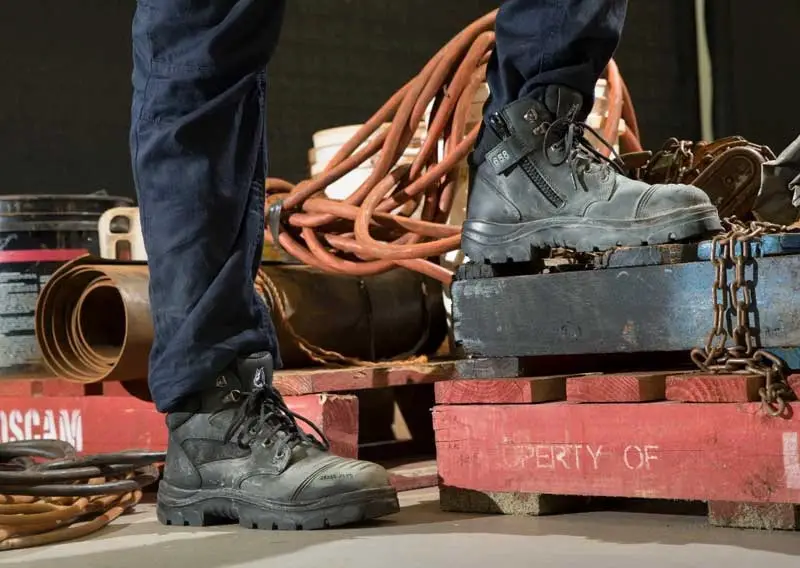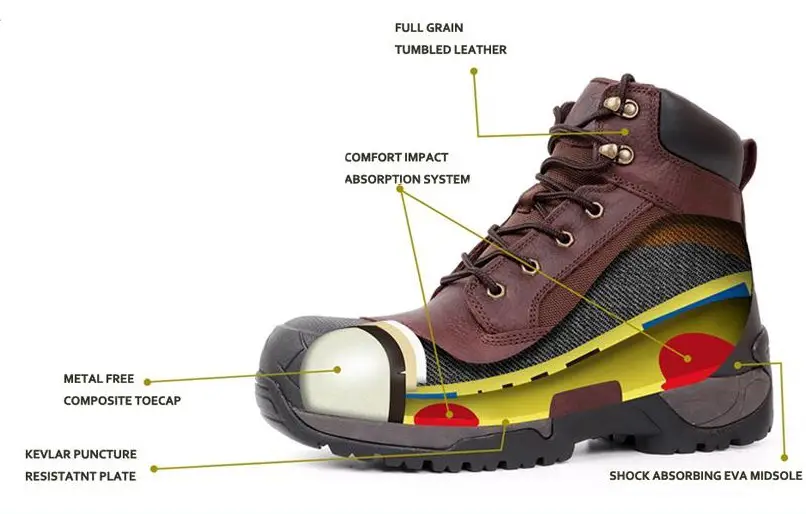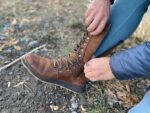Your steel toe work boots may be crucial to your toes’ safety if you operate a hazardous facility like we do. Traditional safety features like steel toes safeguard workers like us all over the world. We don’t want to be seen walking around with toes missing, after all.
Boots with steel toes are excellent for protecting our forefoot. However, there have been cases where the steel inside safety toe boots have rust since oxygen and water are always present in close proximity to steel toe boots while you’re working, and therefore, the metal may begin to show signs of rust pretty soon.
Not all steel toe boots are water-resistant. Unless you purchase the stainless steel variety or if the boots you purchased are completely waterproof, they may rust if you frequently get them wet.

But why does steel rust?
Steel has always had a significant flaw despite being one of the most popular and practical manufactured materials in the world- it corrodes.
On older structures, such as bridges and buildings, as well as on steel that has simply been exposed to the elements for too long, we frequently see the dark brown or red color and flaky material.
Any iron-based material that comes into contact with water and oxygen will rust. Steel is the most highly manufactured man-made material that is susceptible to rust because it is almost entirely made of iron.
So what can you go for instead?
If you worry about your steel toe boots rusting, you can always go for other options like composite toe and alloy toe boots.
Let us understand what are the differences between each safety toe option.
What are Composite toes?

Composite toes are made of strong non-metal materials like Kevlar, carbon fiber, plastic, or fiberglass. Composite toe boots are excellent for work sites with metal detectors because they contain no metal. They provide better resistance as well.
Boots with composite toes are considerably lighter than those with steel toes. For you to wear them comfortably for longer periods of time, they frequently have comfort technology built into the design.
Since composite toe boots are less sensitive to environmental temperature than steel toe boots, they are a better option for outdoor use.
Composite toe boots do not withstand impacts as well as steel toe boots, despite meeting safety standards.
Also, composite toes do not rust no matter the amount of time you have them around.
What are alloy toes?
Foot protection can take many different forms, and like steel toe cap shoes, alloy toes are made to protect your toes and adhere to the same safety standards.
However, instead of using steel caps, these toe guards combine alloys like aluminum and titanium, among others, to protect your feet.
As the name implies, alloy toe cap shoes use a combination of other lightweight materials in place of steel, making them incredibly comfortable to wear.
They are lightweight, so employees can wear them all day without discomfort. They do cost a bit more than their steel toe equivalents.
Here is a comparison chart of the three safety toes:
| Steel toe | Composite toe | Allow toe | |
| Material | Steel | Kevlar, carbon fiber, plastic, or fiberglass | aluminum, titanium, and other lightweight materials. |
| Weight | 1.5-1.8 kg approx | 0.9- 1 kg approx | 0.5-0.7 kg approx |
| Application | Used by loggers, construction workers | Apt for electrical hazardous environment- electricians | Apt for longer hours of work |
| Cost | Cheap, approx $100- $200 | $150- $250 approx | $130- $200 approx |
| Best boots | Timberland PRO Steel Toe Industrial Work Boot. | Carhartt Waterproof Nano Comp Toe Boot. | Timberland PRO Hyperion Alloy Safety Toe Boot. |
| Find it on amazon | Timberland PRO Pitboss Steel Toe | Carhartt Ground Waterproof | Timberland PRO Hyperion Waterproof-Steel |
Keeping the rusting feature aside, steel toe boots have so much more to offer. Let us find out more.
Benefits of Steel Toe boots
1.) It keeps your feet safe
Steel toe boots’ greatest advantage is that it significantly improves workplace safety. They will protect your feet from a variety of potential risks and dangers if you work on or near construction sites.
The metal around the boots toe makes sure the foot is adequately shielded from impacts, penetration, or punctures caused by falling objects or uneven work surfaces.
Additionally, they can protect you from protruding objects that may be sharp.
2.) It provides protection and comfort
Although you might not think so, steel toe boots are actually very comfortable and serve more than just a practical purpose.
With a variety of steel toe work boots, you can stay on your feet all day long without experiencing blisters, sore spots, or aches.
Additionally, they have a ton of built-in support to guarantee that any weak points in the foot, like the ankle or arches, are kept safe and well-supported.
While other work boots may offer a comparable level of comfort, they lack the crucial stability, security, and protection from all risks and accidents.
3.) They’re appropriate for all kinds of weather
Look for a pair of sturdy, waterproof steel toe boots if you work outside. These will improve your comfort and safety while you work because they have additional features in addition to making sure that water cannot enter the boot.
These include additional traction on the bottom of the shoe for stability when negotiating slick terrain or scaling wet stairs, ladders, or scaffolding.
Just keep in mind that there are various waterproofing types and levels. If you work in a hot or muggy environment, choose a waterproof but uninsulated boot to prevent your feet from getting too hot or uncomfortable.
4.) They’ll last a very long time
Finally, the durability of high-quality steel toe boots is another huge advantage. Boots with steel toes are designed to withstand impact and punctures from flying or sharp objects. As a result, they are built to withstand extreme weather and working conditions for many years.
This level of durability is simply not available in regular shoes. In fact, this is the main reason why most building or construction sites demand that workers wear steel toe.
Drawbacks of Steel toe boots
1.) They are heavier than their composite toe counterparts
Wearing steel toe boots all day at work is very taxing due to the additional weight of the steel that they contain. They are heavier than composite and alloy toe boots.
2.) Steel-toed boots can crush your toes.
Steel toe boots can stand upto 6000 pounds of weight. However, if something heavier than that drops on the steel toe boots, the steel could get crushed and your toes could get crushed as well. Nevertheless, the likelihood of this happening is incredibly low.
3.) Wearing steel toe boots is not very comfortable.
First of all, steel toe caps are very heavy, and secondly, the steel material is very hard and takes up a lot of space in the toe box area, which leaves very little room for the toes to move around freely.
All of these factors taken together make wearing steel toe boots uncomfortable.
4.) The steel inside tends to rust
As mentioned above, steel rust when they are constantly exposed to water or oxygen. So even if your steel toe boots are waterproof, some moisture might seep in through the fabric and find its way to rust the steel inside.
Can you protect steel toe boots from rusting?
Steel is a metal that is bound to rust, no matter what treatment you do. However, there are methods through which we can slow down the process of rusting.
We cannot cut open the toe region of the work boot to treat the steel, therefore, we must look for steel toes that are treated with zinc phosphate which will act as a barrier against the external condition that makes steel rust.
Another method is to look for steel toe boots that are treated with epoxy. Epoxy is an organic coating, whereas zinc phosphate is a surface pretreatment.
Moreover, to slow down the rusting process is to buy work boots that are completely waterproof, and additionally treat it with some waterproofing spray so that there is a double layer of protection and moisture and rain cannot get inside the boot.
If your boots are absolutely impermeable, there are less chances of them rusting soon.
To conclude, steel toe boots are one of the safest boots for the workplace. When you are working in a dangerous environment where heavy things could fall on your feet and crush them, steel toe boots come to your rescue.
But steel toe boots come with a few drawbacks too, but the good things it has to offer definitely outweighs the cons.
All you need to do is to check your steel toe boots from time to time, and if it is time for you to change them (showing signs of wear and tear, rust), get a new pair for yourself.







